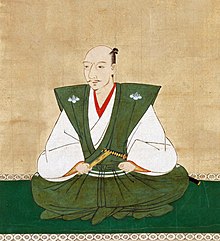Nobunaga Oda
| Oda Nobunaga 織田信長 |
|
|---|---|

Oda Nobunaga in a 16th-century portrait by Kanō Motohide
|
|
| Issue | |
| Father | Oda Nobuhide |
| Mother | Tsuchida Gozen |
| Born |
June 23, 1534 Nagoya Castle, Owari Province |
| Died | June 21, 1582 (aged 47) Honnō-ji, Kyoto |
Oda Nobunaga (織田 信長 ![]() Oda Nobunaga ?, June 23, 1534 – June 21, 1582) was a powerful daimyō of Japan in the late 16th century who attempted to unify Japan during the late Sengoku period. Nobunaga was regarded as one of three unifiers of Japan along with his retainers Toyotomi Hideyoshi and Tokugawa Ieyasu. Nobunaga was widely known as one of the most brutal figures in history, eliminating anyone who stood in his way. He was both a skilled ruler and keen businessman, strategizing at both the micro- and macroeconomic scales. He met his demise when his retainer Akechi Mitsuhide rebelled against him at Honnō-ji.
Oda Nobunaga ?, June 23, 1534 – June 21, 1582) was a powerful daimyō of Japan in the late 16th century who attempted to unify Japan during the late Sengoku period. Nobunaga was regarded as one of three unifiers of Japan along with his retainers Toyotomi Hideyoshi and Tokugawa Ieyasu. Nobunaga was widely known as one of the most brutal figures in history, eliminating anyone who stood in his way. He was both a skilled ruler and keen businessman, strategizing at both the micro- and macroeconomic scales. He met his demise when his retainer Akechi Mitsuhide rebelled against him at Honnō-ji.
The goal of national unification and a return to the comparative political stability of the earlier Muromachi period was widely shared by the multitude of autonomous daimyōs during the Sengoku period. Oda Nobunaga was the first for whom this goal seemed attainable. Nobunaga had gained control over most of Honshu (see map below) before his death during the 1582 Honnō-ji incident, a coup attempt executed by Nobunaga's vassal, Akechi Mitsuhide. It is not certain whether Nobunaga was killed in the attack or else committed seppuku. The motivations behind Mitsuhide's betrayal was never revealed to anyone who survived the incident, and has been a subject of debate and conjecture ever since the incident.
...
Wikipedia
